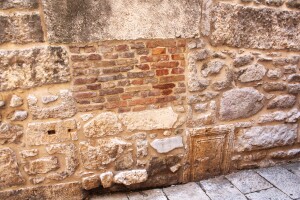Stroll around Zadar
Started our exploring early this morning. Out of the apartment by 9am to check out some of the morning activities. Lots of people already on the street and even more crossing the bridge to come into Old Town. Looks like it’s a usual Saturday shopping day here in Zadar.
 There are a lot of small booths set up throughout the town selling all sorts of produce, seafood, and goods. Just outside our apartment is a row of a dozen such vendors selling mostly clothes and items for the home. Further down the street there is another market. This one had many stalls selling fruits and vegetables, while a side building had stalls of fish and seafood for sale. Nice to see there’s a place nearby where we can get our fresh octopus and squid.
There are a lot of small booths set up throughout the town selling all sorts of produce, seafood, and goods. Just outside our apartment is a row of a dozen such vendors selling mostly clothes and items for the home. Further down the street there is another market. This one had many stalls selling fruits and vegetables, while a side building had stalls of fish and seafood for sale. Nice to see there’s a place nearby where we can get our fresh octopus and squid.



 We joined a small walking tour of the city sponsored by Free Walking Tours, which isn’t free but only costs what you want to pay. This is a 2-hour tour of the major sites around the town with a history lesson provided by the guide. Our guide not only has a background in history, he taught history here at the high school level, and was also born here so he has intimate knowledge of the area. None of which we will remember or be able to pass along to you in this blog so I’ll have to resort to reading up on the sites.
We joined a small walking tour of the city sponsored by Free Walking Tours, which isn’t free but only costs what you want to pay. This is a 2-hour tour of the major sites around the town with a history lesson provided by the guide. Our guide not only has a background in history, he taught history here at the high school level, and was also born here so he has intimate knowledge of the area. None of which we will remember or be able to pass along to you in this blog so I’ll have to resort to reading up on the sites.
Zadar is small community that has a very religious background. This became obvious as we started to explore the 17 churches scattered around the city. And because it lies on the Adriatic Sea and has a deep-water channel, it’s been the target for hostile take-over for centuries. Of course, with each new ruler came a new church, and yes, the Romans were here also.
Sometime around 48 BC, under Julius Caesar, Zadar became a Roman colonia, a stronghold to keep conquered territories secure. Four years later, 44 BC, on March 15th Jules would meet his death at the hands of the Senate. His successor, his nephew Octavian, took over as Augustus Caesar and the Roman Republic ended and the Roman Empire began.
Over the next few decades Zadar was built into a small version of Rome with a grid road network, a Capitolium, and a forum modeled after the one in Rome. During this time, 44-2BC, the shoreline was much further out, about 2 kilometers (1.24 miles), and ground level was lower, about 20 meters (65’). As with most ancient cities, once they fell into disrepair, or were abandoned / conquered, new buildings were built on top of the old buildings that had been demolished and / or back filled with debris to support the new structures. Over time, the ground was raised to accommodate more buildings and a new street level was created. This process was repeated many times until you have today’s streets, which in this case, are 20 meters above the early Roman streets. There are several areas in the city with thick glass plates over excavated ruins so you can see the ancient street level below.
What visitors see today are mostly foundations and broken columns. Zadar was struck by an earthquake in 6th century that destroyed almost everything standing. There is a single Roman column that remains standing in its original position, the Column of Shame, which still has chains and hooks attached to it. This column, as the name implies, was used to punish those who committed acts against society. Collette refused to let me chain her to the column for this writing. Like I wouldn’t let her down or something.

Repair ancient wall using parts from buildings (bottom center), ancient drains (left center), and bricks
 That’s it for Part #1 of our walking tour. Stay tuned for Part #2.
That’s it for Part #1 of our walking tour. Stay tuned for Part #2.
Pics around town…

 Before we go, we came across an interesting custom in Zadar. It seems that when you park illegally, they crane your car away. Darndest thing I ever saw!
Before we go, we came across an interesting custom in Zadar. It seems that when you park illegally, they crane your car away. Darndest thing I ever saw!





















